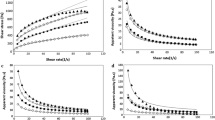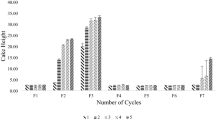Abstract
Batter liquid–solid phase interactions can play a critical role in determining the functionality, including adherence, appearance and texture of end use coated product. Batter chemical composition is a key factor affecting batter characteristics. The effect of substituting wheat flour with fractions of rice flour, native corn starch, modified waxy corn starch, tapioca starch and lupine flour ranging from 26 to 56% of the solid phase and egg levels ranging from 6 to 35% of the liquid phase on the rheological properties of batter systems was studied. Results indicated that lupine flour had the greatest water holding capacity (WHC) ranging from 93.9 to 119.3% of various lupine flour percent to egg levels used. Flow behaviour index of batter flour treatments ranged from 0.91 to 1.87; values that were significantly (P < 0.05) greater than a 100% control wheat flour. Consistency coefficient of treatments ranged from 0.01 to 0.37 mPa sn; values that were significantly lower than wheat flour (i.e., 5 mPa sn). Egg level used in this study had minimal effect on treatment rheological properties. The changes in WHC and viscoelastic properties of treatments were attributed to changes in protein and fibre contents and structure as a result of replacing wheat flour with starch/flour. Protein–starch–lipid matrix formation and variation in water absorption kinetics of treatments most probably wrought batter functionality. The increase in pasting properties with the increase in starch/flour contribution suggested an increased contribution of starch in forming a net effect of batter treatments pasting viscosities. Results of this study provide vital information for the potential use of starch types to enhance the rheological properties of coating applications including adhesion and water holding capacity of substituted batter treatment.


Similar content being viewed by others
References
R.A. Abdelrahman, Influence of chemical properties of wheat-lupine flour blends on cake quality. Am. J. Food Sci. Technol. 2, 67–75 (2014)
F.M. Abu-Salem, E.A. Abou-Arab, Physicochemical properties of Tempeh produced from chickpea seeds. J. Am. Sci. 7, 107–118 (2011)
I. Allais, R.B. Edoura-Gaena, J.B. Gros, G. Trystram, Influence of egg type, pressure and mode of incorporation on density and bubble distribution of a lady finger batter. J. Food Eng. 74, 198–210 (2006)
A. Ashwini, K. Umashankar, R. Jyotsna, P. Prabhasankar, Development of hypoimmunogenic muffins: batter rheology, quality characteristics, microstructure and immunochemical validation. J. Food Sci. Technol. 53(1), 531–540 (2016)
A. Ashwini, R. Jyotsns, D. Indrani, Effect of hydrocolloids and emulsifiers on the rheological, microstructural and quality characteristics of eggless cake. Food Hydrocoll. 23, 700–707 (2009)
D. Bose, M. Shams-Ud-Din, The effect of chickpea (Cicer arietinim) husk on the properties of cracker biscuits. J. Bangladesh Agric. Univ. 8(1), 147–152 (2010)
P. Chaikham, A. Apichartsrangkoon, Comparison of dynamic viscoelastic and physicochemical properties of pressurised and pasteurised longan juices with xanthan addition. Food Chem. 15–134(4), 2194–2200 (2012)
R.G. Changala, N.S. Susheelamma, R.N. Tharanathan, Viscosity pattern of native and fermented black gram flour and starch dispersions. Starch/Stärke 41(3), 84–88 (1989)
H.H. Chen, H.Y. Kang, S.D. Chen, The effects of ingredients and water content on the rheological properties of batters and physical properties of crusts in fried foods. J. Food Eng. 88, 45–54 (2008)
S.H. Chiang, C.S. Chen, C.Y. Chang, Effect of wheat flour protein compositions on the quality of deep-fried gluten balls. J. Food Chem. 97, 666–673 (2006)
M. Christaki, T. Van Dyck, P. Verboven, B. Nicolai, P. Goos, L. Claes, Cake ingredients and processing influence batter rheology, cake volume and texture. International Symposium of Food Rheology and Structure (ISFRS), Zurich, 2015. ISBN 978-3-905609-67-7
S.F. Dogan, S. Sahin, G. Sumnu, Effects of soy and rice flour addition on batter rheology and quality of deep-fat fried chicken nuggets. J. Food Eng. 71, 127–132 (2005)
S.B. Elhardallou, A.F. Walker, The water-holding capacity of three starchy legumes in the raw, cooked and fibre-rich fraction forms. Plant Food Human Nutr. 44(2), 171–179 (1993)
S.M. Fiszman, A. Salvador, Recent developments in coating batters. Trends Food Sci. Technol. 14, 399–407 (2003)
M. Fittipaldi, L.A. Rodriguez, L.R. Grace, The effect of water absorption on the viscoelastic properties of poly(styrene-blockisobutylene-block-styrene) for use in biomedical applications. AIP Conf. Proc. (2015). https://doi.org/10.1063/1.4918393
V. Grinberg, V.B. Tolstoguzov, Thermodynamic incompatibility of proteins and polysaccharides in solution. Food Hydrocoll. 11, 145–158 (1997)
S. Ketjarut, T. Suwonsichon, R. Pongsawatmanit, Rheological properties of wheat flour-based batter containing tapioca starch. Kasetsart J. Natl. Sci. 44, 116–122 (2010)
V. Kiosseoglou, Egg yolk protein gels and emulsions. Curr. Opin. Colloid Interface Sci. 8, 365–370 (2003)
H. Levent, N. Bilgicli, Effect of gluten-free flours on physical properties of cakes. J. Food Sci. Eng. 1, 354–360 (2011)
E.P. Lopez, Influence of the addition of lupine protein isolate on the protein and technological characteristics of dough and fresh bread with added Brea Gum. Food Sci. Technol. 34(1), 195–203 (2014)
C. Marco, C.M. Rosell, Effect of different protein isolates and transglutaminase on rice flour properties. J. Food Eng. 84, 132–139 (2008)
W.E. Marshall, W.R. Goynes, F.L. Normand, Effect of lipid and protein removal on starch gelatinization in whole grain milled rice. Cereal Chem. 67, 458–463 (1990)
A. Mukprasirt, T.J. Herald, R.A. Flores, Rheological characterization of rice flour-based batters. J. Food Sci. 65, 1194–1197 (2000)
P.D. Ribotta, A. Colombo, C.M. RoselL, Enzymatic modifications of pea protein and its application in protein-cassava and corn starch gels. Food Hydrocoll. 27(1), 185–190 (2012)
M.I. Saleh, Protein-starch matrix microstructure during rice flour pastes formation. J. Cereal Sci. 74, 183–186 (2017)
M.I. Saleh, K. Ismail, R. Ajo, Pasta quality as impacted by the type of flour and starch and the level of egg addition. J. Texture Stud. (2017). https://doi.org/10.1111/jtxs.12238
A.T. Salvador, S. Sanz, M. Fiszman, Dynamic rheological characteristics of wheat flour-water doughs: effect of adding NaCl, sucrose and yeast. Food Hydrocoll. 20, 780–786 (2006)
W.G.T. Sanjeewa, J.P.D. Wanasundara, Z. Pietrasik, P.J. Shand, Characterization of chickpea (Cicer arietinum L.) flours and application in low-fat pork bologna as a model system. Food Res. Int. 43, 617–626 (2010)
T. Sanz, A. Salvador, M. Fiszman, Effect of concentration and temperature on properties of methylcellulose-added batters application to battered, fried seafood. Food Hydrocoll. 18, 127–131 (2004)
F. Shih, K. Daigle, Oil uptake properties of fried batters from rice flour. J. Agric. Food Chem. 47, 1611–1615 (1999)
E.L. Sliwinski, P. Kolster, T. Van Vliet, Large-deformation properties of wheat dough in uni- and bi-axial extension: part I—flour dough. Rheol. Acta 43, 306–320 (2014)
N. Sozer, Rheological properties of rice pasta dough supplemented with proteins and gums. Food Hydrocoll. 23, 849–855 (2009)
G.M. Turkut, H. Cakmak, S. Kumcuoglu, S. Tavman, Effect of quinoa flour on gluten-free bread batter rheology and bread quality. J. Cereals Sci. 69, 174–181 (2016)
J. Xu, J.A. Bietz, C.J. Carriere, Viscoelastic properties of wheat gliadin and glutenin suspensions. Food Chem. 101, 1025–1030 (2007)
J. Xue, M. Ngadi, Rheological properties of batter systems containing different combinations of flours and hydrocolloids. J. Sci. Food Agric. 87, 1292–1300 (2007)
Author information
Authors and Affiliations
Corresponding author
Rights and permissions
About this article
Cite this article
Saleh, M. Wheat batter physical properties as influenced by starch/flour types and egg contents. Food Measure 12, 800–807 (2018). https://doi.org/10.1007/s11694-017-9694-z
Received:
Accepted:
Published:
Issue Date:
DOI: https://doi.org/10.1007/s11694-017-9694-z




